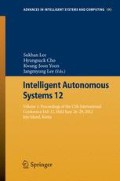Abstract
This paper presents a method for pixel-wise segmentation of moving regions using sparse motion cues on an image from a freely moving camera. The main idea is to utilize residual motion, i.e., motion relative to a background, on sparse grid points. Our algorithm consists of three parts: global motion estimation, characterization of points based on sparse motion cue, and pixel-wise labeling of moving regions. Experimental results on real image sequences are presented, showing the effectiveness of the proposed method.
Access this chapter
Tax calculation will be finalised at checkout
Purchases are for personal use only
Preview
Unable to display preview. Download preview PDF.
References
Poppe, C., Bruyne, S.D., Paridaens, T., Lambert, P., Walle, R.V.D.: Moving object detection in the H.264/AVC compressed domain for video surveillance applications. Journal of Visual Communication and Image Representation 20(6), 428–437 (2009)
Lenz, P., Ziegler, J., Geiger, A., Roser, M.: Sparse scene flow segmentation for moving object detection in urban environments. In: IEEE Intelligent Vehicles Symposium, pp. 926–932 (2011)
Kundu, A., Krishna, K.M., Sivaswamy, J.: Moving object detection by multi-view geometric techniques from a single camera mounted robot. In: IEEE/RSJ International Conference on Intelligent Robots and Systems, pp. 4306–4312 (2009)
Bouwmans, T., El Baf, F., Vachon, B.: Background modeling using mixture of gaussians for foreground detection - A Survey. Recent Patents on Computer Science 1(3), 219–237 (2008)
Stauffer, C., Grimson, W.: Learning patterns of activity using real-time tracking. IEEE Transactions on Pattern Analysis and Machine Intelligence 22(8), 747–757 (2000)
Baker, S., Scharstein, D., Lewis, J.P., Roth, S., Black, M.J., Szeliski, R.: A Database and Evaluation Methodology for Optical Flow. International Journal of Computer Vision 92, 1–31 (2011)
Liu, F., Gleicher, M.: Learning color and locality cues for moving object detection and segmentation. In: IEEE Conference on Computer Vision and Pattern Recognition, pp. 320–327 (2009)
Wang, Y., Ji, Q.: A dynamic conditional random field model for object segmentation in image sequences. In: IEEE Computer Society Conference on Computer Vision and Pattern Recognition (CVPR), pp. 264–270 (2005)
Klappstein, J., Vaudrey, T., Rabe, C., Wedel, A., Klette, R.: Moving object segmentation using optical flow and depth information. In: Proc. Pacific-Rim Symposium on Image and Video Technology, Tokyo, Japan, pp. 611–623 (2009)
Bugeau, A., Perez, P.: Detection and segmentation of moving objects in complex scenes. Computer Vision and Image Understanding 113(4), 459–476 (2009)
Han, M., Xu, W., Gong, Y.: Video object segmentation by motion-based sequential feature clustering. In: 14th Annual ACM International Conference on Multimedia (2006)
Su, Y., Sun, M.-T., Hsu, V.: Global motion estimation from coarsely sampled motion vector field and the applications. IEEE Transactions on Circuits and Systems for Video Technology 15(2), 232–242 (2005)
Lucas, B.D., Kanade, T.: An iterative image registration technique with an application to stereo vision. In: International Joint Conference on Artificial Intelligence, pp. 674–679 (1981)
Huber, P.J.: Robust statistics. John Wiler, New York (1981)
Haller, M., Krutz, A., Sikora, T.: Evaluation of pixel- and motion vector-based global motion estimation for camera motion characterization. In: Proc. WIAMIS, pp. 49–52 (2009)
Meer, P., Mintz, D., Rosenfeld, A., Kim, D.Y.: Robust Regression Methods for Computer Vision: A Review. International Journal of Computer Vision 6(1), 59–70 (1991)
Shi, J., Tomasi, C.: Good Features to Track. In: IEEE Conference on Computer Vision and Pattern Recognition(CVPR), pp. 593–600 (1994)
Lafferty, J., McCallum, A., Pereira, F.: Conditional random fields: Probabilistic models for segmenting and labeling sequence data. In: ICML, pp. 282–289 (2001)
Szeliski, R., et al.: A Comparative Study of Energy Minimization Methods for Markov Random Fields with Smoothness-Based Priors. IEEE Transactions on Pattern Analysis and Machine Intelligence 30(6), 1068–1080 (2008)
Datasets - Segmented foreground objects, http://www.sfu.ca/~ibajic/datasets.html
KLT: An Implementation of the Kanade-Lucas-Tomasi Feature Tracker, http://www.ces.clemson.edu/~stb/klt/
Wu, M., Peng, X., Zhang, Q.: Segmenting moving objects from a freely moving camera with an effective segmentation cue. Measurement Science & Technology 22(2) (2011) (article Number 025108)
Sand, P., Teller, S.: Particle Video: Long-Range Motion Estimation using Point Trajectories. In: IEEE Computer Society Conference on Computer Vision and Pattern Recognition (CVPR), pp. 2195–2202 (2006)
Author information
Authors and Affiliations
Corresponding author
Editor information
Editors and Affiliations
Rights and permissions
Copyright information
© 2013 Springer-Verlag Berlin Heidelberg
About this chapter
Cite this chapter
Kang, J., Kim, S., Oh, T.J., Chung, M.J. (2013). Moving Region Segmentation Using Sparse Motion Cue from a Moving Camera. In: Lee, S., Cho, H., Yoon, KJ., Lee, J. (eds) Intelligent Autonomous Systems 12. Advances in Intelligent Systems and Computing, vol 193. Springer, Berlin, Heidelberg. https://doi.org/10.1007/978-3-642-33926-4_24
Download citation
DOI: https://doi.org/10.1007/978-3-642-33926-4_24
Publisher Name: Springer, Berlin, Heidelberg
Print ISBN: 978-3-642-33925-7
Online ISBN: 978-3-642-33926-4
eBook Packages: EngineeringEngineering (R0)

